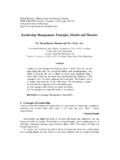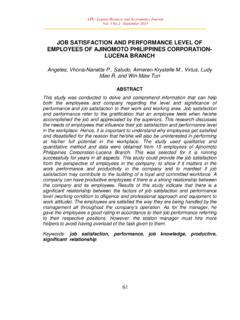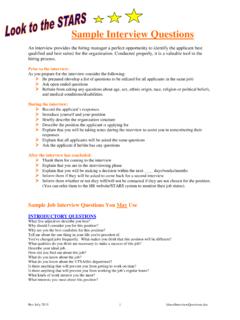Transcription of A descriptive literature review of harmful leadership ...
1 Creighton Journal of Interdisciplinary leadership Vol. 3, No. 1, July 2017, pp. 33 52 2017 W. A. Burns Creighton Journal of Interdisciplinary leadership DOI: review A descriptive literature review of harmful leadership styles: Definitions, commonalities, measurements, negative impacts, and ways to improve these harmful leadership styles Wallace A. Burns, Jr., American Military University, Associate Professor, School of Business, Abstract There are many harmful leadership styles the egotistic leader, the incompetent leader, the ignorant leader, and leaders that are reckless, cruel, or even evil. To understand what ultimately are considered leadership traits that are contrary to good order, discipline and productivity, the author conducted a review of the literature to obtain a current typology (the grouping of items by their similarities) of selected harmful leadership styles specific styles that are counter to enabling others to succeed, overcome challenges, achieve desired results, and create a positive environment in which to work.
2 The paper focused on three distinctly harmful leadership styles (abusive, bullying, and toxic), and set these in context with each other and within the domain of destructive leadership in general. Commonalities, measurements, negative impacts, and ways to improve these harmful leadership styles were identified from the literature and detailed. The paper concluded with recommendations for future research and action. Keywords: harmful leadership , toxic leadership , abusive leadership , bullying, destructive leadership , toxic leadership scale Introduction eople who work for harmful leaders often have no choice in the matter, have been found to love their jobs in spite of working for such leaders, or are unfortunate pawns of history. The more fortunate work for good leaders who are inspirational, have integrity, set a good example, and are supportive and encouraging. This paper focuses on the harmful leadership traits of destructive leaders.
3 There are many harmful leadership types the egotistic leader, the incompetent leader, the ignorant leader, and leaders that are reckless, cruel, or even evil. To understand what ultimately are considered leadership traits that are contrary to good order, discipline and productivity, the author conducted a review of the literature to obtain a current typology of selected harmful leadership styles specific styles that are counter to enabling others to succeed, overcome challenges, achieve desired results, and create a positive environment in which to work. The paper defined several harmful leadership styles, including those considered toxic, abusive, bullying, and disruptive, and set these in context with each other and within the spectrum of destructive leadership . Then, commonalities, measurements, negative impacts, and ways to improve these harmful leadership styles were identified from the literature and discussed.
4 Finally, very broad conclusions on the way ahead were drawn. Purpose The purpose of the paper was to provide a useful typology for better understanding harmful leadership styles. The paper addressed the following four areas of inquiry. First, the research P W. A. Burns 34 focused on the commonalities and characteristics of the main categorizations of harmful leadership , including abusive leadership , bullying, and toxic leadership . Second, negative consequences or outcomes of these harmful leadership styles were explored and compiled. Third, the paper draws from the literature ways these harmful leadership styles are commonly measured and assessed. Last, the author provided critical analysis of the research to identify candidate topics for further inquiry and how the negative effects of harmful leadership might be mitigated. Definitions This section defines both constructive and destructive leadership before introducing and focusing on three embodiments of destructive and harmful leadership : abusive, bullying, and toxic.
5 Constructive leadership Constructive leadership combines a focus on both mission accomplishment and team welfare. One without the other could lead to a weakening of the synergy needed to excel as a team consistently. Constructive leaders couple human traits such as honesty, respect, sincerity, justice, and honor with organizational/team strengths such as confidence, direction, achievement and striving for the greater good. Team members respect and place their trust in constructive leaders, in direct contrast to what occurs when led by a destructive leader (Norman, Avolio, & Luthans, 2010). Destructive leadership Kathie Pelletier (2010) defined destructive leadership as the systematic and repeated behaviour by a leader, supervisor, or manager that violates the legitimate interest of the organisation by undermining and/or sabotaging the organisation s goals, tasks, resources, and effectiveness and/or motivation , well-being or job satisfaction of subordinates (p.)
6 375). Destructive leadership , she stated, .. can involve acts of physical force ( , shoving, throwing things, slamming fist on a desk, sexual harassment that includes inappropriate physical contact), and passive acts such as failing to protect a subordinate s welfare, or failing to provide a subordinate with important information or feedback. (p. 375) Aasland, Skogstad, Notelaers, Nielsen, and Einarsen (2010) added that destructive leadership is not one type of leadership behavior, but instead involves a variety of behaviors, that it 1) involves systematically acting against the legitimate interest of the organization, whether by abusing subordinates or by working against the attainment of the organization s goals, including any illegal behaviour, and 2) emphasizes repeated destructive behaviour as opposed to a single act such as an isolated outburst of anger or spontaneous misbehaviour (p.
7 439). Pinning down the definition of destructive leadership is a challenge. Elle (2012) argued that destructive leadership is a manifestation of multiple toxic leadership styles. Steele (2011) provided that destructive leaders use dominance, coercion, and manipulation, as opposed to constructive leaders who use influence, persuasion, and commitment. Reed and Bullis (2009) offered that destructive leadership , toxic leadership , and petty tyranny are used interchangeably. This is why this paper chooses to subordinate toxic leadership under the broad category of destructive leadership . Destructive leadership appears to be lessening as a problem, as it is less acceptable and tolerated in modern organizations. Reed and Olsen (2010) cited senior leaders who believe that the problem of destructive leadership used to be much worse than it is today.
8 Nevertheless, the problem of destructive leadership remains far-reaching. According to harmful leadership styles 2017 W. A. Burns Creighton Journal of Interdisciplinary leadership DOI: 35 Gallus, Walsh, Driel, Gouge, and Antolic (2013), this harmful leadership style has deep roots both psychologically and organizationally. Einarsen and Skogstad (2007) developed a model of destructive and constructive leadership behavior, as illustrated in Figure 1: Figure 1. Model of destructive and constructive leadership behavior The relationships in Figure 1 establish understandable boundaries between what is considered constructive leadership (pro-subordinate and pro-organization behavior) and what is inferred as destructive (anti-subordinate and/or anti-organization behavior. Each harmful leadership style is a blend of negative leader behavior covered later in the section entitled Commonalities.)
9 Found within the literature surfaced three distinct harmful leadership styles: abusive, bullying, and toxic, discussed in detail below. Abusive leadership According to Tepper (2000) and Tepper, Duffy, Hoobler, and Ensley (2004) abusive leaders are characterized by their injurious actions that include public ridicule, angry tantrums, inconsiderate actions ( , rudeness), favoritism, non-contingent punishment, and coercion (p. 374). Hornstein (1996) suggested that toxic leaders are primarily concerned with gaining and maintaining control through methods that create fear and intimidation (p. 374). Ashforth (1994) argued tyrannical leaders are distrusting, condescending and patronizing, impersonal, arrogant and boastful, and rigid and inflexible. They take credit for the efforts of others, blame subordinates for mistakes, discourage informal interaction among subordinates, and deter initiative and dissent (p.)
10 374). Mawritz, Mayer, Hoobler, Wayne, and Marinova (2012) found that abusive supervision has effects beyond the supervisor subordinate dyad, which appears according to numerous research efforts to be a common tell-tale of harmful leadership styles. Tepper (2007) provided antecedents of abusive supervision, including organizational injustice, perceived psychological contract breach, and negative affect (p. 1268). Aryee, Chen, Sun, and Debrah (2007) argued that as a counterproductive behavior, abusive supervision is influenced by the interactive effect of supervisors perceptions of interactional injustice and authoritarian leadership style. Further, subordinates perceptions of interactional justice rather than procedural justice account for the influence of abusive supervision on affective organizational commitment (p. 200). W. A. Burns 36 Bullying Schmidt (2008) identified that bullying was sufficiently different in scope and meaning from supervisory mistreatment such as abusive supervision (p.


















